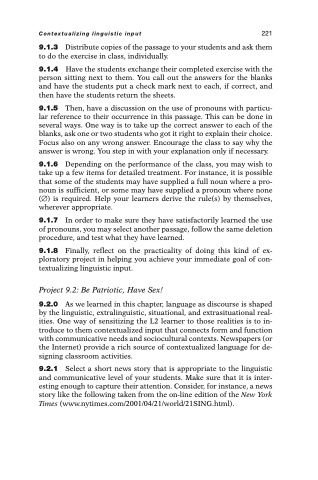Page 233 - Beyond Methods
P. 233
Contextualizing linguistic input 221 9.1.3 Distribute copies of the passage to your students and ask them
to do the exercise in class, individually.
9.1.4 Have the students exchange their completed exercise with the person sitting next to them. You call out the answers for the blanks and have the students put a check mark next to each, if correct, and then have the students return the sheets.
9.1.5 Then, have a discussion on the use of pronouns with particu- lar reference to their occurrence in this passage. This can be done in several ways. One way is to take up the correct answer to each of the blanks, ask one or two students who got it right to explain their choice. Focus also on any wrong answer. Encourage the class to say why the answer is wrong. You step in with your explanation only if necessary.
9.1.6 Depending on the performance of the class, you may wish to take up a few items for detailed treatment. For instance, it is possible that some of the students may have supplied a full noun where a pro- noun is sufficient, or some may have supplied a pronoun where none () is required. Help your learners derive the rule(s) by themselves, wherever appropriate.
9.1.7 In order to make sure they have satisfactorily learned the use of pronouns, you may select another passage, follow the same deletion procedure, and test what they have learned.
9.1.8 Finally, reflect on the practicality of doing this kind of ex- ploratory project in helping you achieve your immediate goal of con- textualizing linguistic input.
Project 9.2: Be Patriotic, Have Sex!
9.2.0 As we learned in this chapter, language as discourse is shaped by the linguistic, extralinguistic, situational, and extrasituational real- ities. One way of sensitizing the L2 learner to those realities is to in- troduce to them contextualized input that connects form and function with communicative needs and sociocultural contexts. Newspapers (or the Internet) provide a rich source of contextualized language for de- signing classroom activities.
9.2.1 Select a short news story that is appropriate to the linguistic and communicative level of your students. Make sure that it is inter- esting enough to capture their attention. Consider, for instance, a news story like the following taken from the on-line edition of the New York Times (www.nytimes.com/2001/04/21/world/21SING.html).


